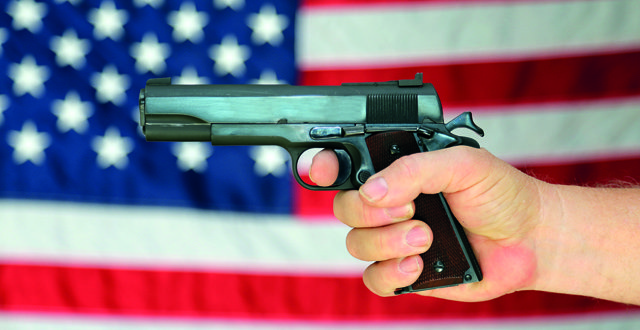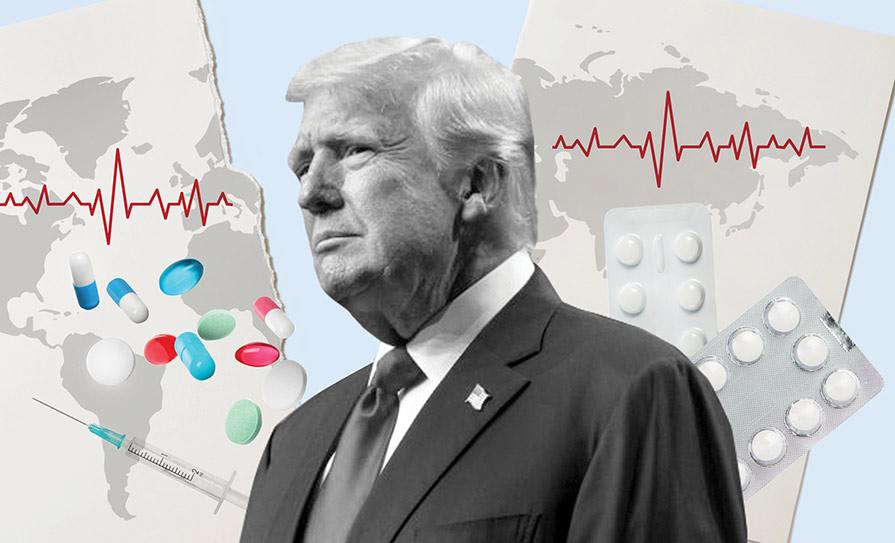Gun violence is spreading unabated across the US like an infectious disease, with more than 36,000 people dying each year from its effects.
That figure puts gun-related mortality ahead of diseases such as HIV/AIDS, Parkinson’s, hypertension, intestinal infection, peptic ulcer, anaemia, viral hepatitis, biliary tract disease and atherosclerosis, and has sparked calls for an approach that treats the issue as a public health epidemic and not just a policing problem.
While on an average day, 100 Americans are killed by guns, at least twice as many are injured, according to the gun safety group Everytown, with gun injuries resulting in higher rates of rehospitalisation and chronic disability than for those suffering injuries as a result of car accidents.
The toll on survivors’ mental health is also great. Those exposed to mass shootings are known to experience acute elevations in depression, anxiety and post-traumatic stress symptoms.
In addition, rates of psychological distress and subsequent mental health illness are also high among first responders and hospital-based personnel, such as emergency department staff. Emergency response personnel have approximately twice the lifetime risk for developing post-traumatic stress disorder.
“Gun violence is a public health crisis, evident by the senseless loss of life and injury in Las Vegas,” the American Medical Association (AMA) tweeted after the massacre that killed 58 people in Las Vegas last October. It called for steps like background checks and waiting periods for gun ownership. One month later, while the country was still reeling from the Las Vegas massacre, another gunman killed 26 people in a Texas church on 5 November.
The AMA adopted its policy of calling gun violence a public health issue in 2016. “With [over] 30,000 men, women and children dying each year at the barrel of a gun in elementary schools, movie theatres, workplaces, houses of worship and on live television, the United States faces a public health crisis of gun violence,” AMA President Dr Steven Stack said after the Pulse nightclub shooting in Orlando that killed 49 people that year.
The American College of Physicians is equally alarmed. It has been labelling gun violence a public health issue for more than 20 years and has called for legislation that would ban the sale and ownership of automatic and semi-automatic weapons.
The American Academy of Paediatrics wants to see tight gun laws that protect children in every US state. In the state of Nevada, for example, where last October’s massacre occurred, owners of firearms are not required to have licences, register their weapons or pass a waiting period before buying a firearm, and there is no limit on the number of guns someone can own.
“The American Academy of Paediatrics advocates for strong state and federal gun laws that protect children in every state of the nation. Despite the fact that these types of events have become all too common in our daily lives, we must not grow complacent in our reaction to them, and instead renew our resolve to stop them from occurring again and again,” the Academy’s CEO Dr Karen Remley, and its President, Dr Fernando Stein, said in a joint statement.
A recent study by Johns Hopkins University found that, apart from deaths, injuries from gun shootings in the US are costing $2.8 billion in hospital charges.
“This terrible tragedy [in Las Vegas] is another reminder that we still need to address the role of gun violence in our country,” Dr Georges Benjamin, Executive Director of the American Public Health Association, emphasised after last October’s attack. “Individuals everywhere deserve laws that protect them from random acts of violence like this one.”
But while the country’s leading medical organisations speak with one voice on the health crisis posed by the proliferation of guns, the crisis continues unabated so that now, gun violence is the third-leading injury-related cause of death in America, only behind drug overdose and motor vehicle accidents. The <em>Journal of the American Medical Association</em> (<em>JAMA</em>) sums up the problem like this: “The key to reducing firearm deaths in the United States is to understand and reduce exposure to the cause, just like in any epidemic, and in this case that is guns.”
<h3><strong>‘Epidemic’</strong></h3>
The public policy research arm of the US Congress recently highlighted the extent of this “epidemic” with a particularly chilling statistic — more Americans have died from gunfire in their own country in the last 50 years than died in all the wars the US has ever fought, the Congressional Research Service said.
The numbers are indeed terrifying: From the period of the American War of Independence in 1776 to 2014, 1.2 million Americans have died in military conflicts, while the number of firearm fatalities since 1963 is higher than 1.5 million.
But if the problem has reached such horrific proportions, and medical professionals agree it is an alarming crisis, the question arises as to why so little is being done to address it. The answer is essentially down to three factors: Wealth, power and politics.
The wealth and power of the gun industry in America, like that of the tobacco industry before it, has effectively silenced and enfeebled political leaders who cower before its might. The record shows that the majority of Democrats and Republicans have continually chosen to protect their own careers over the health and safety of their constituents.
They are doing this because they have learned the hard way what happens to those who challenge the pro-gun agenda of the industry’s leading lobby group, the National Rifle Association (NRA) —they lose their jobs. That is exactly what happened two decades ago after Democratic members of Congress backed then President Bill Clinton’s assault weapons ban. This ban expired in 2004 and has never since been reinstated.
<h3><strong>Research</strong></h3>
The NRA has also reached into the halls of US Congress to tame the research work of the Centres for Disease Control and Prevention (CDC). While gun violence is one of the leading causes of death in America, it is also one of the most poorly researched, according to a study this year in <em>JAMA</em>.
“In relation to mortality rates, gun violence research was the least-researched cause of death and the second-least funded cause of death after falls,” the study’s authors wrote.
The AMA has also pointed out that research would help officials understand the problems associated with gun violence and would determine how to reduce the number of firearm deaths and injuries. “An epidemiological analysis of gun violence is vital so physicians and other health providers, law enforcement and society at large may be able to prevent injury, death and other harms to society resulting from firearms.”
However, under pressure from the NRA, the US Government has spent the last 20 years stifling research on gun violence. The CDC had been conducting research into gun violence as a “public health phenomenon” and began publishing studies that indicated a strong correlation between the presence of guns and firearm-related deaths.
Prof Fred Rivara, Professor of Paediatrics and Epidemiology at the University of Washington and Seattle Children’s Hospital, found in one study funded by the CDC that having a gun in the home increases the risk of homicide and suicide three-fold.
The news sent the NRA on the offensive. Alarmed at this negative press, the powerful pro-gun lobby swung into action and in 1996, reportedly in response to pressure from the organisation, the US Congress cut the CDC’s budget by $2.6 million.
On the face of it, it was not a huge slice of the CDC’s $2.2 billion allocation but it sent a chilling message, since $2.6 million was exactly the amount the CDC’s National Centre for Injury Prevention and Control had spent in 1995 on studies of firearm injuries. After the budget cut, Congress passed an amendment that effectively banned the funding of gun-related research by the CDC.
The amendment stated that “none of the funds made available for injury prevention and control at the Centres for Disease Control and Prevention may be used to advocate or promote gun control”. While the amendment was not an outright ban on funding research on gun violence, it served as a powerful deterrent against researching the gun menace. Similar language was added to the budget in 2011 for the National Institute of Health (NIH) and other US federal health agencies.
The NRA proudly took credit for the research restrictions. “These junk-science studies and others like them are designed to provide ammunition for the gun control lobby by advancing the false notion that legal gun ownership is a danger to the public health instead of an inalienable right,” it said.
Although the CDC ultimately got the $2.6 million restored, the assault on the agency’s gun research alarmed many in the medical profession. The <em>New England Journal of Medicine</em> called it “an attack that strikes at the very heart of scientific research”.
Reuters reported in 2013 that US government research into gun mortality shrank by 96 per cent since the NRA’s successful campaign in the 1990s.
<em>JAMA</em> noted last year that only $22 million in federal funds had been devoted to gun violence research between 2004 and 2015 and concluded that in relation to mortality rates, gun violence was the least-researched cause of death. It was estimated that if the research had been funded at the same rate as other leading causes of death, gun violence research would have received $1.4 billion.
“To be sure, colon cancer kills more people than gun violence, but the difference in federal funding for gun violence prevention research cannot be explained by this fact alone,” Dr Marjorie Rosenthal, herself a cancer patient, told the TV news channel CNN. “In the United States, gun violence kills about 10 people per 100,000 per year and colon cancer kills about 15 people per 100,000 per year, but colon cancer research funding is more than 100 times what gun violence prevention research is.”
In 2015, over 2,000 doctors in all 50 US states plus the District of Columbia signed a petition urging Congress to remove these barriers to common sense research that have existed for nearly 20 years and include annual funding to identify causes and ways to prevent gun violence.
“Gun violence is a public health problem that kills 90 Americans a day,” said Dr Alice Chen, Executive Director of Doctors for America, in 2015. “Physicians believe it’s time to lift this effective ban and fund the research needed to save lives. We urge Congress to put patients over politics to help find solutions to our nation’s gun violence crisis.”
After the 2012 killing of 22 children at Sandy Hook Elementary School, then US President Barack Obama issued an executive order reinstating gun violence prevention research at the NIH, which sponsored $18 million worth of gun violence-related research until the order lapsed in January 2017.
The projects have now come to a halt under the administration of President Donald Trump. His only significant action on guns to date has been to sign a law rolling back Obama-era limitations on the ability of those being treated for mental illness to purchase guns.
This is hardly surprising. The NRA strongly endorsed him during his 2016 presidential campaign, declaring: “We will stand and we will fight with everything we’ve got and in 2016, by God, we will elect our next great President of the United States of America and it will not be Hillary Rodham Clinton.” It then went on to back up its words financially, spending more than $30 million to help Trump defeat his Democratic challenger.
<img src=”../attachments/c0066b5b-6aaf-4187-a829-21560e872d4c.JPG” alt=”” />
<h3><strong>Children </strong></h3>
The phrase ‘Guns don’t kill people, people kill people’ is constantly parroted by those in favour of maintaining the status quo. But what about children? On average, 5,790 children in the US receive medical treatment in an emergency department each year for a gun-related injury. About 21 per cent of those injuries are unintentional.
From 2012 to 2014, on average, 1,297 children died annually in the US from a gun-related injury, according to a study published in the journal <em>Paediatrics</em> last summer.
“Firearm injuries are a leading cause of death among US children aged one-to-17 years and contribute substantially each year to the premature death, illness and disability of children,” said the study’s lead author Dr Katherine Fowler, a behavioural scientist from the CDC.
The Harvard School of Public Health’s Injury Control Research Centre also points out that the overwhelming majority of firearms researchers and suicide experts agree that a gun in the home increases the risk of suicide. A gun is discharged in a US school about once a week, according to Everytown.
This figure includes those that are accidental or don’t result in any injuries or fatalities.
“I believe it is our fault as adults that we have created this dangerous environment [for children],” says Prof David Hemenway, Director of the Injury Control Research Centre. “Adults in every other developed country have done better by their children.”
<h3><strong>Silencing doctors</strong></h3>
But it is not for want of trying by medical professionals.
The NRA has also been active in the area of rules concerning doctors and their rights to discuss gun safety with their patients. “Physicians interrogating and lecturing parents and children about guns is not about gun safety,” the NRA said. “It is a political agenda to ban guns. Parents do not take their children to physicians for a political lecture against the ownership of firearms; they go there for medical care.”
A legal battle over medical professionals’ rights to discuss the issue of gun safety in the home with patients has been going through the US courts for a number of years.
A Florida law, introduced in 2011 and supported by the NRA, targeted paediatricians who asked parents about firearms in the home. Under its provisions, doctors could be punished with a fine of up to $10,000 and could lose their medical licences for discussing guns with patients. This applied even if there were concerns about suicide — the CDC’s Injury Statistics Query and Reporting System points out that 60.7 per cent of the gun deaths in 2015 in the US were suicides.
In 2015, a Florida court upheld the 2011 law, saying that a doctor “should not disparage firearm-owning patients and should not persist in attempting to speak to the patient about firearm ownership.”
But in February this year, a federal appeals court struck down the law, ruling that doctors could not be threatened with losing their licence for asking patients if they owned guns and for discussing gun safety because to do so would violate their free speech rights.
“Florida does not have <em>carte blanche</em> to restrict the speech of doctors and medical professionals on a certain subject without satisfying the demands of heightened scrutiny,” the majority wrote in the decision. In the lawsuit, dubbed ‘Docs v Glocks’ after the popular American handgun, the medical community argued that questions about gun storage were crucial to public health because of the relationship between firearms and both the suicide rate and the gun-related deaths of children.
“As with any epidemic, prevention is important,” <em>JAMA</em> emphasised. “Physicians and others should ask about guns in the home, especially for high-risk patients, and advise about removal and safe storage. Good evidence has shown that safe storage of firearms is effective in reducing misuse.”
Many doctors in Florida felt gratified when the law was struck down. “There was a general sense of relief,” one Florida-based doctor, who requested confidentiality, told the <strong><em>Medical Independent</em></strong> (<strong><em>MI</em></strong>). “Doctors must be allowed to communicate freely with their patients.”
<h3><strong>Culture</strong></h3>
The US is one of the few countries in the world in which the right to bear arms is constitutionally protected — Mexico, Haiti and Guatemala are other examples. This means the booming US gun industry has wrapped its pro-gun agenda in the protective mantle of Constitutional rights as it continues to produce lethal weapons, the likes of which could never have been imagined by the framers of the Constitution over 200 years ago.
If the statistics for gun killings are chilling, so too are the ownership figures: America has 4.4 per cent of the world’s population, but almost half of the civilian-owned guns around the world. Their proliferation is evident if you travel around America. I have an abiding memory of walking into a supermarket in South Carolina not long after I arrived in America two decades ago to find shelves crammed with more guns than groceries. In fact, there are now more than 300 million guns in the country, or one for every man, woman and child of the population.
But talk of controlling these weapons does not go down well in Washington, which earlier this year saw the dismissal by the Trump administration of the nation’s top doctor, Surgeon General Dr Vivek Murthy, who was a staunch advocate of gun regulation and who had publicly identified gun violence as a public health crisis.
While political leaders may feel the heat after mass shootings such as the attacks on the Sandy Hook school, in Las Vegas or in the Texas church, most tend to respond with prayers rather than policies that might upset the NRA and other gun-rights advocates.
Others tend to avoid the issue or seek scapegoats. On the day after the Texas tragedy on the 5 November, for example, President Trump said mental illness, not the issue of gun control, was to blame for the massacre.
Earlier this year, however, he lifted the Obama-era gun checks for people with severe mental illness. “This isn’t a guns situation,” President Trump said. “This is a mental health problem at the highest level.”
But experts say that drawing a simplistic connection between mental illness and severe violence not only sends the wrong message about psychological disorders, it stigmatises those who suffer with mental health conditions.
In addition, the US Department of Health and Human Services directed <strong><em>MI</em></strong> to its research, which found the vast majority of people with mental health problems are no more likely to be violent than anyone else: “In fact, people with severe mental illnesses are over 10 times more likely to be victims of violent crime than the general population,” according to its research.
And even when politicians do face-up to the real issue and act to control the proliferation of guns, legal challenges inevitably follow. A ban on handguns in Washington, for example, was found unconstitutional by the Supreme Court because the justices said the Second Amendment of the US Constitution protects an individual’s right to possess a gun for self-defence.
Calls for action by medical professionals to tackle America’s gun violence epidemic, therefore, look likely to fall on deaf ears for a long time to come because it appears that the right to bear arms under the country’s Second Amendment trumps the protection of life and liberty under the Fifth Amendment.













Leave a Reply
You must be logged in to post a comment.